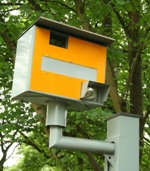Should authorities turn their speed cameras back on?
By Bob Bluffield
As more authorities debate turning off their speed cameras, in a sudden about-turn Oxfordshire County Council has turned theirs back on. The county was one of the first authorities to withdraw their funding for cameras, estimated at £600,000, which led to safety campaigners questioning their wisdom. Thames Valley Police announced that 72 fixed cameras and 89 mobile sites that were turned off last August were to be re-activated across the county from 1 April. According to a spokesman, funding will now be found from backroom savings and drivers attending speed awareness courses.
The decision to re-activate the cameras was taken following claims that an increase in speeding drivers had led to a greater number of collisions. Thames Valley Police reported that 83 people had been injured in 62 accidents at the sites of fixed cameras. Professor Stephen Glaister, the Director of the RAC Foundation concurs that the cameras have played a major part in cutting accidents. Speaking in March, he said: "Speed cameras are controversial, but work done for us suggests that nationally each year they save 800 people from being killed or seriously injured."
drivers had led to a greater number of collisions. Thames Valley Police reported that 83 people had been injured in 62 accidents at the sites of fixed cameras. Professor Stephen Glaister, the Director of the RAC Foundation concurs that the cameras have played a major part in cutting accidents. Speaking in March, he said: "Speed cameras are controversial, but work done for us suggests that nationally each year they save 800 people from being killed or seriously injured."
A spokesperson for Oxfordshire County Council said that the decision would be "welcomed by the majority of drivers" adding: "Speed cameras are not the only way of saving life on the roads but Oxfordshire County Council has recognised they are part of it. Hopefully other councils considering turning off their cameras will not rethink their positions."
After tests were carried out by removing the cameras in Watlington Road, Cowley and on the A44 in Woodstock over a 5-day period last August, they showed a marked rise in speeding drivers of 88% and 18% respectively. During the trial period drivers were not prosecuted but Inspector Paul Winks of Thames Valley Police described the results in August as "disappointing". He said: "It clearly means switching off the cameras has given a green light to a small number of people to break the law. The consequence is more death and more death is unacceptable."
There are mixed opinions over the part cameras contribute to the reduction of accidents although an authority's decision to de-activate is more likely to depend on budget considerations. The latest authority to make a decision has been Northamptonshire who switched their cameras off on 25 March 2011, although the police continue to use camera vans in areas where speeding is a concern. The local authority in Swindon turned their cameras off in July 2009. In August the Road Safety Partnership that was operated jointly by Wiltshire Police, Swindon Council and the County Council closed down through lack of funding and, according to their website, mobile cameras have also been withdrawn by the police across the county. In Staffordshire, 263 cameras costing £800,000have been de-activated but are due to remain in place as a deterrent and at any site where a motorist or pedestrian is seriously injured the camera will be re-activated.